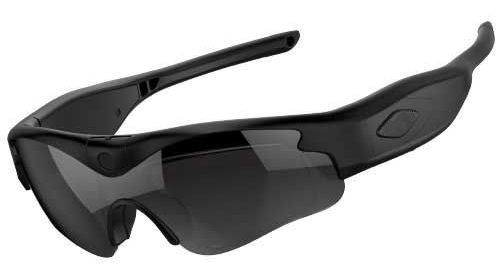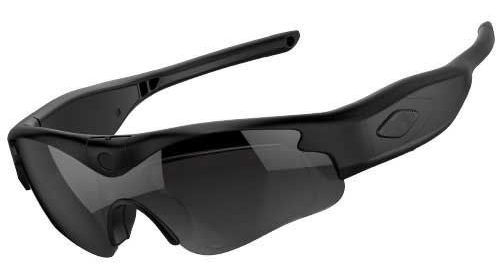What Does Stereo Sound Mean?
What does stereo sound mean? Our daVideo Rikor video camera glasses have two built in AAC2 channel microphones to record realistic stereo sound, but what does this mean?
Stereo Sound
Stereo sound refers to the creation of sound using multiple audio channels. It creates the illusion of sound coming from different directions and is much more effective at mimicking the experience of natural sound than single-channel, mono audio systems. Stereo sound is generally created with a network of at least two speakers located at a regular distance from a listener. These speakers may be as simple as a pair of headphones or as complicated as a vast theater sound system or concert rig. Most modern equipment capable of producing audio is designed primarily to employ stereo sound.
The human ear is designed to locate the source of sound in the environment. A single audio channel cannot fool the brain into believing that it can locate the source of a sound, but two or more sound channels can be combined in order to produce precisely that effect. In stereo sound, audio signals produced by different audio channels are designed and recorded so that the brain naturally interprets their combined signal as being sound from a particular source with a given spatial position.
Originally, stereo audio was recorded using two or more distinct microphones configured to record sounds at their positions, designed to correspond with the ideal locations of playback speakers. This method is still used, with additional permutations and equipment allowing for the recording of four or more audio channels for theater-quality sound. In many cases, however, a version of stereo sound is now produced digitally, with computer software modeling the sound from different positions. A similar process can be used to convert mono tracks to stereo sound and is sometimes used in the re-mastering of older audio tracks.
FOR DETAILS AND ORDERING INFO CLICK HERE
Most modern media systems are designed for stereo sound, though AM radio is one exception to this general trend. The technology does not support stereo very efficiently, leading to the dominance of talk radio in the AM spectrum. FM radio is generally broadcast in stereo because the medium effectively supports stereo signal transmission, making FM a more natural medium for music.
Stereo sound is not necessarily a better option than mono sound. In some environments, such as crowded dance clubs or large concerts, the difference between stereo and mono may not be noticeable to the audience. Small or inexpensive sound systems may also not be able to produce stereo sound that is notably better than mono. In most cases, stereo audio is configured to provide a sense of being in a real sound space but cannot be arranged so that most listeners could truly pinpoint the location of individual sounds.

Stereophonic sound or, more commonly, stereo, is a method of sound reproduction that creates an illusion of multi-directional audible perspective. This is usually achieved by using two or more independent audio channels through a configuration of two or more loudspeakers (or stereo headphones) in such a way as to create the impression of sound heard from various directions, as in natural hearing. Thus the term “stereophonic” applies to so-called “quadraphonic” and “surround-sound” systems as well as the more common two-channel, two-speaker systems. It is often contrasted with monophonic, or “mono” sound, where audio is heard as coming from one position, often ahead in the sound field (analogous to a visual field). In the 2000s, stereo sound is common in entertainment systems such as broadcast radio, TV, recorded music, and cinema.
Stereo Sound Description
Stereo sound systems can be divided into two forms: the first is “true” or “natural” stereo in which a live sound is captured, with any natural reverberation or ambience present, by an array of microphones. The signal is then reproduced over multiple loudspeakers to recreate, as closely as possible, the live sound.
Secondly “artificial” or “pan-pot” stereo, in which a single-channel (mono) sound is reproduced over multiple loudspeakers. By varying the relative amplitude of the signal sent to each speaker an artificial direction (relative to the listener) can be suggested. The control which is used to vary this relative amplitude of the signal is known as a “pan-pot” (panoramic potentiometer). By combining multiple “pan-potted” mono signals together, a complete, yet entirely artificial, sound field can be created.
In technical usage, true stereo means sound recording and sound reproduction that uses stereographic projection to encode the relative positions of objects and events recorded.
During two-channel stereo recording, two microphones are placed in strategically chosen locations relative to the sound source, with both recording simultaneously. The two recorded channels will be similar, but each will have distinct time-of-arrival and sound-pressure-level information. During playback, the listener’s brain uses those subtle differences in timing and sound level to triangulate the positions of the recorded objects. Stereo recordings often cannot be played on monaural systems without a significant loss of fidelity. Since each microphone records each wavefront at a slightly different time, the wavefronts are out of phase; as a result, constructive and destructive interference can occur if both tracks are played back on the same speaker. This phenomenon is known as phase cancellation.

FOR DETAILS AND ORDERING INFO CLICK HERE
daVideo Rikor
Our unique patented designed daVideo Rikor 1080p camera sunglasses have a vertically tiltable camera lens that can be adjusted 12° downward and 10° upward. The water resistant frame is made of a super light weight & flexible Grilamid TR90 material, and shaped to fit different head sizes. Our Z87.1 standard, UV400, interchangeable quality lenses are 2.2mm thick and are designed to handle the most extreme sports. This unique model also allows you to easily insert your own prescription lenses. Adjustable comfortable nose pads allow a custom fit to meet the needs of all different faces.
The daVideo Rikor 1080p camera glasses record at 1080 @ 30fps or 720 @ 60fps. The 110° wide angle Sony low light sensor lens captures all the action in your videos. The dual channel AAC2 true stereo microphones captures clear audio, with double wheat noise reduction. Built-in WIFI allows you to connect your daVideo Rikor glasses to the iOS/Android app and change settings or instantly save/share your videos with friends.
Click here to see how our most advanced daVideo Rikor camera sunglasses compare with the daVideo Akia and daVideo Presta.
daVideo Rikor Features
HD 1080P / 720P
Records HD 1080P @ 30fps or 720 @ 60fps. Capture perfect point of view video.
TILTABLE LENS
Tilt the camera lens 12° upword or 10° downward to capture the perfect shot.
WIFI / APP
The daVideo Rikor 1080p camera sunglasses can output a wifi signal; wirelessly connect it to any iOS/Android device and app.
IMPACT RESISTANT
Super thick 2.2mm lenses for your video camera glasses. Reinforced frame & impact resistant.
PHOTOS
Your video camera glasses have a built in high quality 12MP camera
Take still photos with a click of a button. Take one picture at a time or take a burst shot of 3 photos at a time.
VIDEO
Compressing format: H.264
Resolution: 1920 x 1080p @ 30fps and 1280 x 720P @ 60fps
Ratio Image: 16:9
VIBRATION NOTIFICATIONS
Video camera sunglasses notify you with vibrating notifications and LED lights
EXPANDABLE MEMORY
Add up to 128gb memory to your video camera sunglasses
LOW TEMPERATURE BATTERY
480mAh high capacity lithium polymer battery handle extreme temperatures between -4 degrees Fahrenheit (-20 degrees Celsius) to 131 degrees Fahrenheit (55 degrees Celsius) Fully charge battery in about 2 hours.
OUR DAVIDEO RIKOR GUARANTEE
Same Day USPS Shipping (order video camera sunglasses by 3pm EST.)
Free Shipping In The USA
UPS Overnight Shipping (USA Only)
Fast Global Shipping
30 Day Returns & 1yr Warranty
Follow us Online
Facebook – Twitter – YouTube – Instagram – Pinterest
daVideo Rikor – daVideo Akia – daVideo Presta – Compare – Track – Contact – Videos – Coupon Codes – Payments – About Us – Become a Dealer – Warranty – Return Policy – Shipping – Troubleshooting – Dropship – Send Videos



